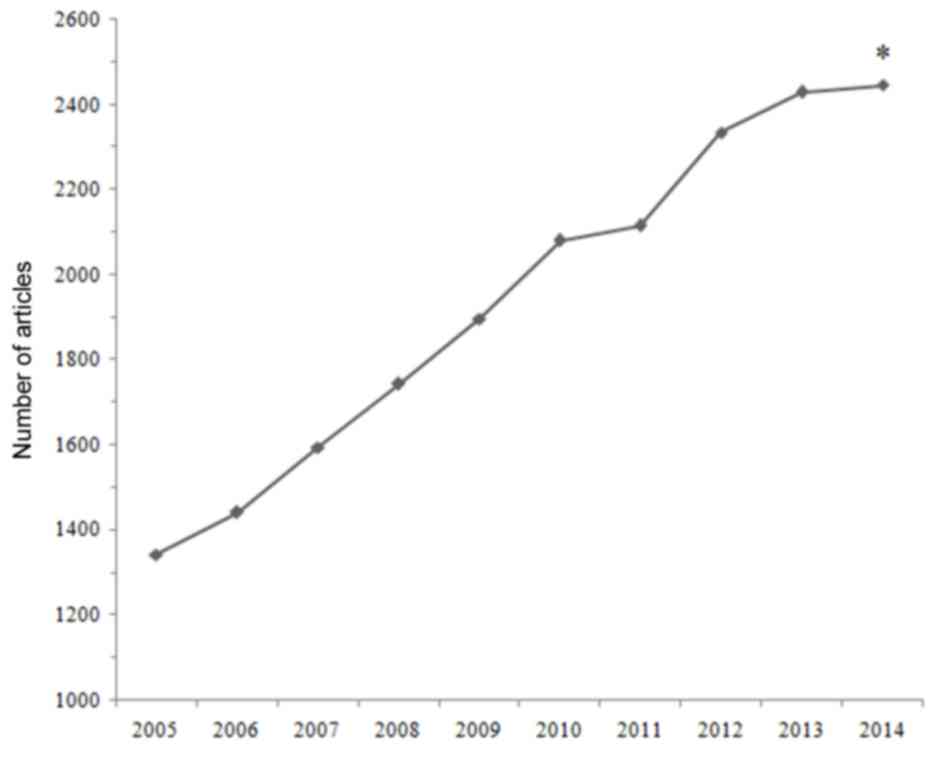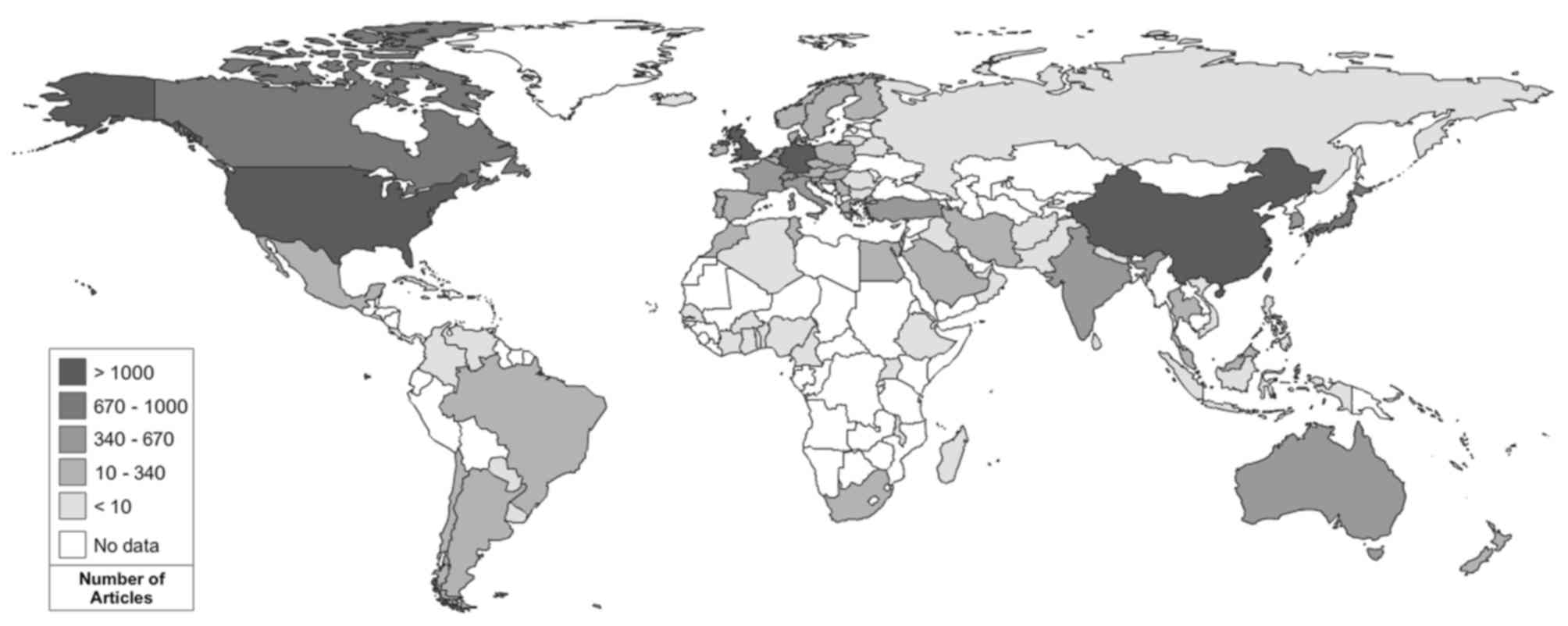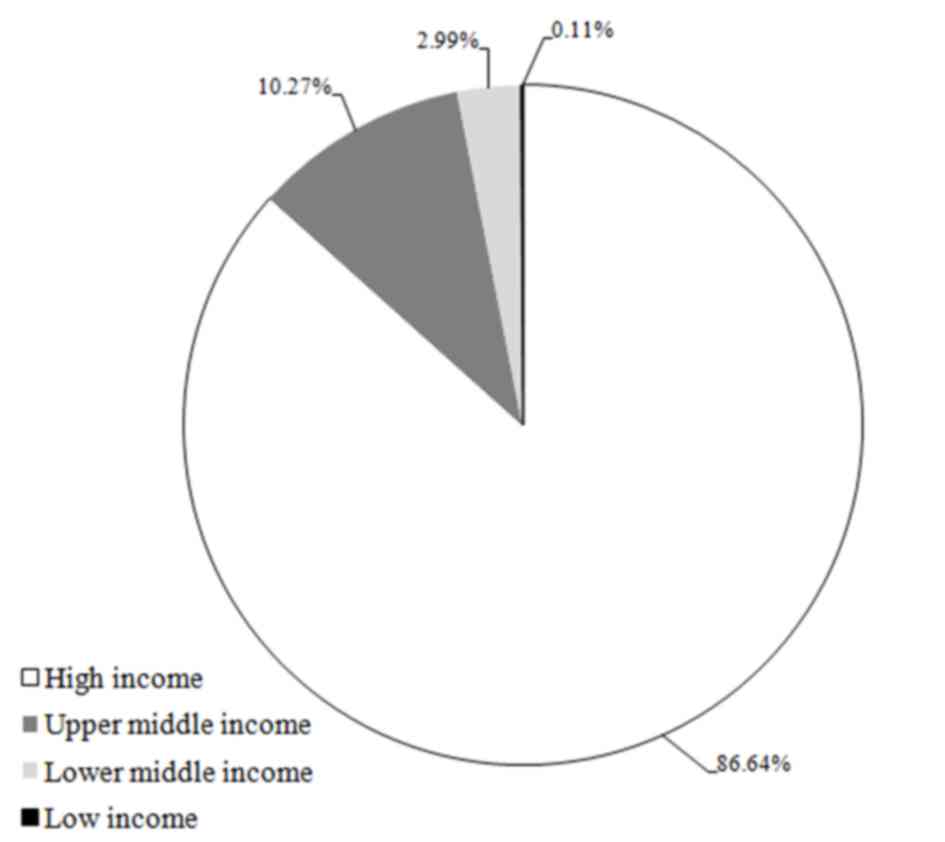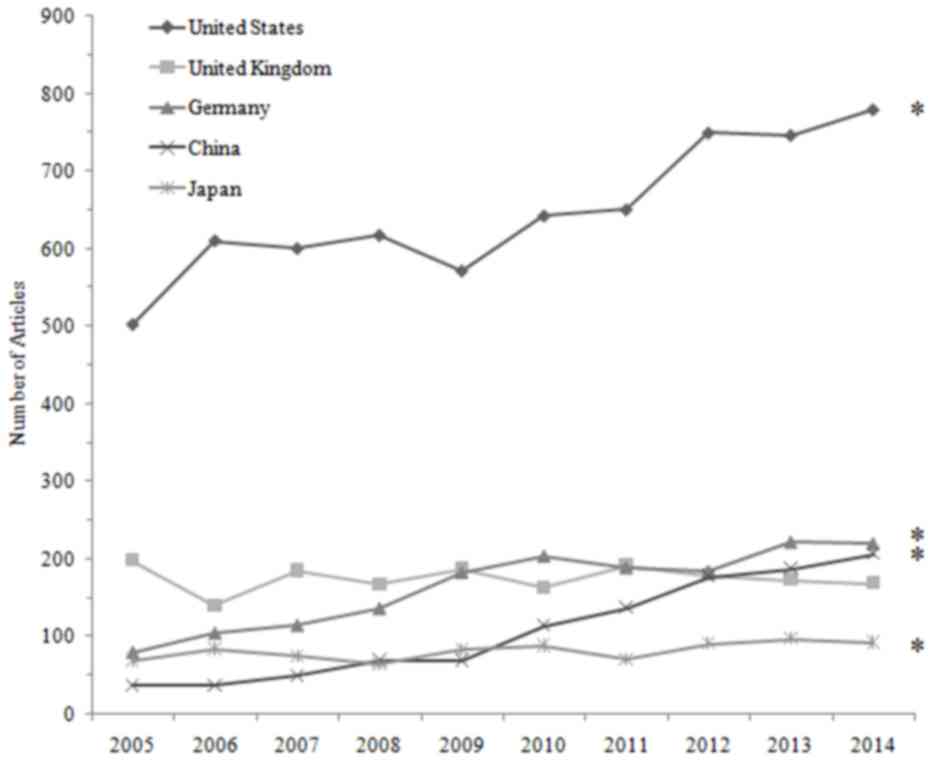Worldwide research productivity in fracture surgery: A 10-year survey of publication activity
- Authors:
- Jianzhong Sun
- Ren Ding
- Tai Ma
- Xiaobing Shi
- Chaolu Bao
- Huapeng Guan
-
View Affiliations
Affiliations: Department of Orthopedics, Shanghai Baoshan Traditional Chinese Medicine‑Integrated Hospital, Shanghai 201999, P.R. China, Department of Orthopedics, The 456th Hospital of The Chinese People's Liberation Army, Jinan, Shandong 250000, P.R. China
- Published online on: June 13, 2017 https://doi.org/10.3892/etm.2017.4585
-
Pages:
1260-1264
Metrics:
Total
Views: 0 (Spandidos Publications: | PMC Statistics:
)
Metrics:
Total PDF Downloads: 0 (Spandidos Publications: | PMC Statistics:
)
This article is mentioned in:
Abstract
Worldwide research contributions have allowed the field of fracture surgery to progress. However, to the best of our knowledge, no studies have documented the main characteristics of publications from different countries. The present study aimed to determine the quantity and quality of worldwide research in fracture surgery. The Web of Science database was searched to identify fracture articles published between 2005 and 2014. The contributions of countries were evaluated based on paper and citation numbers, and the research output of each country was adjusted according to population size. A total of 19,423 papers on the topic of fracture surgery were identified worldwide, and the total number of publications from 2005 to 2014 had significantly increased by 1.82‑fold (P<0.001). The majority of papers (86.64%) were published by high‑income countries (gross national income per capita ≥$12,736), 13.25% by middle‑income countries ($1,046‑12,735) and 0.11% by low‑income countries (≤$1,045). The United States contributed the highest number of publications (33.34%), followed by the United Kingdom (9.03%), Germany (8.42%), China (5.58%) and Japan (4.18%). Furthermore, the United States ranked first according to total citations (72,640). Articles from Sweden achieved the highest average citations per paper (15.63), followed by Australia (12.84) and Canada (12.44). When the number of publications were adjusted for population size, Switzerland was the first (56.39), followed by Austria (35.43) and the Netherlands (30.68). In conclusion, the number of publications in fracture surgery increased from 2005 to 2014, and the majority of fracture papers were published by high‑income countries, while few papers were published by low‑income countries. The United States was the most prolific country, but based on population size, a number of smaller countries in Europe may be relatively more prolific.
View References
|
1
|
Teague DC, Erti WJ, Hickerson L and
Roberts Z: What's new in orthopaedic trauma. J Bone Joint Surg Am.
98:1142–1149. 2016. View Article : Google Scholar : PubMed/NCBI
|
|
2
|
Piétu G and Ehlinger M: Minimal invasive
internal fixation of distal femur fractures. Orthop Traumatol Surg
Res. 103(1S): S161–S169. 2017. View Article : Google Scholar : PubMed/NCBI
|
|
3
|
Kokkalis ZT, lliopoulos ID, Pantazis C and
Panagiotopoulos E: What's new in the management of complex tibial
plateau fractures? Injury. 47:1162–1169. 2016. View Article : Google Scholar : PubMed/NCBI
|
|
4
|
Langer A, Diaz-Olavarrieta C, Berdichevsky
K and Villar J: Why is research from developing countries
underrepresented in international health literature, and what can
be done about it? Bull World Health Organ. 82:802–803.
2004.PubMed/NCBI
|
|
5
|
Mei X, Zhu X, Zhang T, Jia Z and Wang C:
Worldwide productivity in the hand and wrist literature: A
bibliometric analysis of four highly cited subspecicalty journals.
Int J Surg. 28:8–12. 2016. View Article : Google Scholar : PubMed/NCBI
|
|
6
|
Luo X, Liang Z, Gong F, Bao H, Huang L and
Jia Z: Worldwide productivity in the field of foot and ankle
research from 2009–2013: A bibliometric analysis of highly cited
journals. J Foot Ankle Res. 8:122015. View Article : Google Scholar : PubMed/NCBI
|
|
7
|
Liang Z, Luo X, Gong F, Bao H, Qian H, Jia
Z and Li G: Worldwide research productivity in the field of
arthroscopy: A bibliometric analysis. Arthroscopy. 31:1452–1457.
2015. View Article : Google Scholar : PubMed/NCBI
|
|
8
|
Cheng T and Zhang G: Worldwide research
productivity in the field of rheumatology from 1996 to 2010: A
bibliometric analysis. Rheumatology (Oxford). 52:1630–1634. 2013.
View Article : Google Scholar : PubMed/NCBI
|
|
9
|
Zhao X, Ye R, Zhao L, Lin Y, Huang W, He
X, Lian F and Tong X: Worldwide research productivity in the field
of endocrinology and metabolism-a bibliometric analysis. Endokrynol
Pol. 66:434–442. 2015. View Article : Google Scholar : PubMed/NCBI
|
|
10
|
Li Q, Jiang Y and Zhang M: National
representation in the emergency medicine literature: A bibliometric
analysis of highly cited journals. Am J Emerg Med. 30:1530–1534.
2012. View Article : Google Scholar : PubMed/NCBI
|
|
11
|
Saxena S, Paraje G, Sharan P, Karam G and
Sadana R: The 10/90 divide in mental health research: Trends over a
10-year period. Br J Psychiatry. 188:81–82. 2006. View Article : Google Scholar : PubMed/NCBI
|
|
12
|
Akre O, Barone-Adesi F, Pettersson A,
Pearce N, Merletti F and Richiardi L: Differences in citation rates
by country of origin for papers published in top-ranked medical
journals: Do they reflect inequalities in access to publication? J
Epidemiol Community Health. 65:119–123. 2011. View Article : Google Scholar : PubMed/NCBI
|
|
13
|
King DA: The scientific impact of nations.
Nature. 430:311–316. 2004. View
Article : Google Scholar : PubMed/NCBI
|














